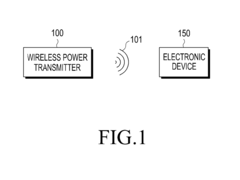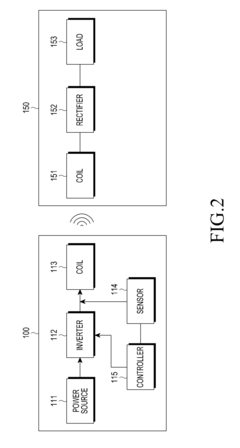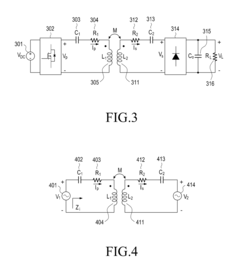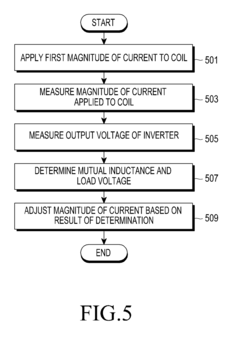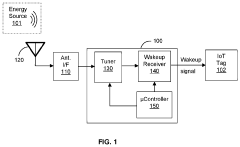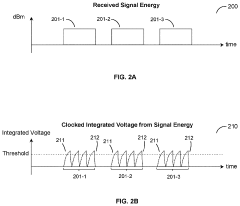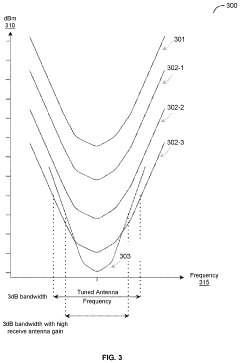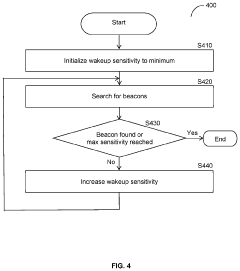Future of Electromagnetic Waves in IoT Devices
EMW in IoT: Background and Objectives
Electromagnetic waves (EMW) have been a cornerstone of wireless communication since the late 19th century. In recent years, their application in Internet of Things (IoT) devices has opened up new frontiers in connectivity and data transmission. The IoT revolution, characterized by the interconnection of everyday objects through the internet, heavily relies on EMW for its functioning and expansion.
The primary objective of this technical research is to explore the future of EMW in IoT devices, focusing on emerging trends, potential breakthroughs, and challenges that lie ahead. As IoT continues to grow exponentially, with billions of devices expected to be connected in the coming years, the role of EMW becomes increasingly critical in ensuring efficient, reliable, and secure communication.
The evolution of EMW technology in IoT can be traced through several key developments. Initially, simple radio frequency identification (RFID) tags marked the beginning of machine-to-machine communication. This was followed by the widespread adoption of Wi-Fi and Bluetooth technologies, which significantly expanded the capabilities of IoT devices. More recently, the introduction of low-power wide-area networks (LPWAN) like LoRaWAN and NB-IoT has further extended the reach and efficiency of IoT applications.
Current trends indicate a move towards higher frequency bands, such as millimeter waves, to accommodate the growing demand for bandwidth and to support emerging technologies like 5G and beyond. Simultaneously, there is a push for more energy-efficient EMW solutions to address the power constraints of IoT devices, particularly in remote or hard-to-reach locations.
The technical goals for the future of EMW in IoT devices are multifaceted. They include increasing data transmission rates while reducing power consumption, improving signal penetration in challenging environments, enhancing security against electromagnetic interference and cyber threats, and developing more compact and integrated antenna designs. Additionally, there is a growing emphasis on cognitive radio technologies that can dynamically adapt to the electromagnetic environment, optimizing spectrum usage and coexistence with other wireless systems.
As we look ahead, the convergence of EMW technology with other cutting-edge fields such as artificial intelligence, edge computing, and advanced materials science promises to unlock new possibilities for IoT applications. This synergy is expected to drive innovation in areas like smart cities, autonomous vehicles, industrial automation, and healthcare, fundamentally transforming how we interact with the world around us.
IoT Market Demand Analysis
The Internet of Things (IoT) market is experiencing rapid growth, driven by the increasing demand for connected devices and smart solutions across various industries. The integration of electromagnetic waves in IoT devices plays a crucial role in this expansion, enabling wireless communication and data transmission. As the IoT ecosystem continues to evolve, the market demand for electromagnetic wave-based technologies in IoT devices is expected to surge significantly.
The global IoT market is projected to reach substantial value in the coming years, with a considerable portion attributed to devices utilizing electromagnetic waves for connectivity. This growth is fueled by the rising adoption of IoT solutions in sectors such as manufacturing, healthcare, agriculture, and smart cities. The demand for real-time data collection, remote monitoring, and automation capabilities is driving the need for efficient and reliable electromagnetic wave-based communication in IoT devices.
In the industrial sector, IoT devices leveraging electromagnetic waves are revolutionizing manufacturing processes through predictive maintenance, asset tracking, and process optimization. The ability to monitor equipment performance and detect potential issues in real-time has led to increased productivity and reduced downtime, creating a strong demand for IoT solutions in this space.
The healthcare industry is another significant driver of IoT market demand, with electromagnetic wave-based devices enabling remote patient monitoring, telemedicine, and asset management in hospitals. The COVID-19 pandemic has further accelerated the adoption of these technologies, highlighting the importance of connected healthcare solutions.
Smart home applications represent a rapidly growing segment of the IoT market, with consumers increasingly embracing connected devices for home automation, security, and energy management. The demand for seamless integration and interoperability among various smart home devices is pushing the development of advanced electromagnetic wave technologies to support multiple communication protocols and standards.
The automotive industry is also contributing to the growing demand for IoT devices utilizing electromagnetic waves. Connected vehicles, autonomous driving systems, and vehicle-to-everything (V2X) communication are driving the need for robust and reliable wireless connectivity solutions. This trend is expected to continue as the automotive sector moves towards greater electrification and autonomy.
As cities worldwide strive to become smarter and more sustainable, the demand for IoT devices in urban infrastructure is rising. Smart lighting, waste management, traffic control, and environmental monitoring systems all rely on electromagnetic wave-based communication to collect and transmit data, creating a significant market opportunity for IoT solution providers.
The agriculture sector is increasingly adopting IoT technologies to improve crop yields, optimize resource usage, and implement precision farming techniques. Electromagnetic wave-based sensors and communication systems enable farmers to monitor soil conditions, weather patterns, and crop health in real-time, driving the demand for IoT solutions in this traditionally low-tech industry.
EMW Tech Status and Challenges
The current state of electromagnetic wave (EMW) technology in IoT devices is characterized by rapid advancements and significant challenges. Globally, the integration of EMW in IoT has seen substantial progress, with applications ranging from smart homes to industrial automation. However, the technology faces several hurdles that need to be addressed for wider adoption and improved performance.
One of the primary challenges is the issue of interference. As the number of IoT devices utilizing electromagnetic waves continues to grow, the risk of signal interference increases exponentially. This is particularly problematic in urban environments where the density of devices is high. Researchers and engineers are actively working on developing more robust signal processing algorithms and advanced modulation techniques to mitigate this issue.
Power consumption remains another significant concern. Many IoT devices are designed to operate on limited power sources, such as batteries or energy harvesting systems. The use of electromagnetic waves for communication can be energy-intensive, potentially limiting the operational lifespan of these devices. Efforts are underway to develop more energy-efficient EMW technologies, including low-power transmission protocols and improved antenna designs.
Spectrum allocation and management present additional challenges. With the increasing demand for wireless connectivity, the available frequency spectrum is becoming increasingly crowded. Regulatory bodies worldwide are grappling with the task of allocating appropriate frequency bands for IoT applications while ensuring minimal interference with existing services.
Security and privacy concerns also pose significant challenges in the EMW-IoT landscape. As these devices often transmit sensitive data, ensuring the integrity and confidentiality of communications is crucial. Researchers are exploring advanced encryption methods and secure protocols specifically tailored for IoT devices with limited computational resources.
Geographically, the development of EMW technology for IoT is not uniformly distributed. Countries with advanced technological infrastructure, such as the United States, China, South Korea, and several European nations, are at the forefront of research and implementation. However, emerging economies are rapidly catching up, recognizing the potential of IoT in various sectors.
Standardization remains a key challenge in the field. The lack of unified standards for EMW communication in IoT devices hinders interoperability and widespread adoption. Various industry consortia and international organizations are working towards developing common standards, but progress has been slow due to competing interests and technological complexities.
Looking ahead, overcoming these challenges will be crucial for realizing the full potential of electromagnetic waves in IoT devices. The future of this technology hinges on innovative solutions that address interference, power efficiency, spectrum management, security, and standardization issues.
Current EMW Solutions for IoT
01 Electromagnetic wave detection and measurement
Various devices and methods for detecting and measuring electromagnetic waves are described. These include sensors, antennas, and specialized equipment designed to capture and analyze electromagnetic signals across different frequencies and intensities.- Electromagnetic wave detection and measurement: Various devices and methods for detecting and measuring electromagnetic waves are described. These include sensors, antennas, and specialized equipment designed to capture and analyze electromagnetic signals across different frequencies and intensities.
- Electromagnetic wave shielding and protection: Technologies for shielding and protecting against electromagnetic waves are presented. This includes materials and structures designed to block or absorb electromagnetic radiation, as well as methods for reducing electromagnetic interference in electronic devices and systems.
- Electromagnetic wave communication systems: Advancements in communication systems utilizing electromagnetic waves are discussed. This encompasses improvements in wireless communication technologies, including antenna designs, signal processing techniques, and methods for enhancing data transmission and reception over electromagnetic waves.
- Electromagnetic wave energy harvesting: Innovations in harvesting energy from electromagnetic waves are explored. This includes methods and devices for capturing and converting ambient electromagnetic radiation into usable electrical energy, potentially for powering low-energy devices or supplementing other power sources.
- Electromagnetic wave applications in medical field: The use of electromagnetic waves in medical applications is presented. This covers diagnostic imaging techniques, therapeutic treatments, and monitoring systems that utilize various forms of electromagnetic radiation to improve healthcare outcomes and patient care.
02 Electromagnetic wave shielding and protection
Technologies for shielding and protecting against electromagnetic waves are presented. These involve materials and structures designed to block, absorb, or redirect electromagnetic radiation, often used in electronic devices, buildings, or protective gear.Expand Specific Solutions03 Electromagnetic wave generation and transmission
Systems and methods for generating and transmitting electromagnetic waves are discussed. This includes various types of transmitters, antennas, and other devices capable of producing and directing electromagnetic radiation for communication, imaging, or other purposes.Expand Specific Solutions04 Electromagnetic wave applications in medical field
The use of electromagnetic waves in medical applications is explored. This covers diagnostic imaging techniques, therapeutic treatments, and monitoring systems that utilize various forms of electromagnetic radiation to improve healthcare outcomes.Expand Specific Solutions05 Electromagnetic wave energy harvesting and conversion
Technologies for harvesting and converting electromagnetic wave energy into usable forms are presented. This includes systems for capturing ambient electromagnetic radiation and converting it into electrical power, as well as methods for improving the efficiency of such conversions.Expand Specific Solutions
Key IoT EMW Players
The electromagnetic wave technology in IoT devices is in a dynamic growth phase, with a rapidly expanding market and increasing technological maturity. The competitive landscape is characterized by a mix of established tech giants and innovative startups. Companies like Samsung, Ericsson, and Qualcomm are leading the charge, leveraging their extensive R&D capabilities and market presence. Universities such as Georgia Tech and Harbin Institute of Technology are contributing significant research. The market is seeing a convergence of telecommunications, consumer electronics, and IoT sectors, with players like NTT and Sony expanding their footprint. As the technology matures, we can expect increased standardization and interoperability, driving further adoption across various IoT applications.
Samsung Electronics Co., Ltd.
Telefonaktiebolaget LM Ericsson
EMW Innovations in IoT
- A wireless power transmitter that measures load voltage and mutual inductance without a communication module by using a power source, inverter, coil, and processor to adjust power output based on measured voltage and current, enabling efficient wireless charging without the need for external sensing information.
- A wake-up circuit that initializes and adjusts sensitivity to detect specific target signals like BLE Advertising events without a reference clock, using over-the-air signals for calibration and frequency tuning to enhance sensitivity and selectivity, thereby reducing false activations and conserving energy.
EMW Spectrum Regulations
The electromagnetic spectrum is a finite resource that requires careful management and regulation to ensure efficient and fair use across various applications, including IoT devices. As the IoT ecosystem continues to expand, the demand for spectrum allocation is increasing, necessitating a comprehensive regulatory framework to address current and future needs.
Regulatory bodies worldwide, such as the Federal Communications Commission (FCC) in the United States and the European Conference of Postal and Telecommunications Administrations (CEPT) in Europe, play crucial roles in establishing and enforcing spectrum regulations. These organizations are responsible for allocating frequency bands, setting power limits, and defining technical standards for IoT devices utilizing electromagnetic waves.
One of the key challenges in spectrum regulation for IoT devices is balancing the need for unlicensed spectrum access with the protection of existing licensed users. Many IoT applications rely on unlicensed bands, such as the Industrial, Scientific, and Medical (ISM) bands, which are becoming increasingly congested. Regulatory bodies are exploring new approaches to spectrum sharing and dynamic access to address this issue.
The concept of spectrum sharing has gained traction in recent years, with regulatory frameworks like the Citizens Broadband Radio Service (CBRS) in the United States allowing for shared access to previously underutilized frequency bands. This approach enables more efficient use of the spectrum while protecting incumbent users, and similar models may be adopted for IoT applications in the future.
As IoT devices continue to evolve and incorporate advanced technologies like 5G and beyond, regulatory bodies are working to adapt their frameworks to accommodate these developments. This includes allocating new frequency bands for 5G and IoT applications, such as the mmWave spectrum, and establishing guidelines for emerging technologies like massive MIMO and beamforming.
International coordination is becoming increasingly important in spectrum regulation for IoT devices, as many applications require global interoperability. Organizations like the International Telecommunication Union (ITU) play a vital role in harmonizing spectrum allocations and technical standards across different regions, facilitating the development of globally compatible IoT solutions.
Looking ahead, regulatory bodies are exploring innovative approaches to spectrum management, such as the use of artificial intelligence and machine learning algorithms to optimize spectrum allocation and usage. These technologies could enable more dynamic and efficient spectrum sharing, potentially revolutionizing the way electromagnetic waves are regulated for IoT devices in the future.
EMW Security in IoT Devices
As the Internet of Things (IoT) continues to expand, the security of electromagnetic waves (EMW) in IoT devices has become a critical concern. The proliferation of connected devices has created new vulnerabilities that malicious actors can exploit, making it imperative to develop robust security measures for EMW communications in IoT ecosystems.
One of the primary challenges in EMW security for IoT devices is the limited computational resources and power constraints of many IoT endpoints. This necessitates the development of lightweight cryptographic protocols and efficient security algorithms that can provide adequate protection without overburdening the devices' capabilities.
Another significant aspect of EMW security in IoT is the need for secure key management and distribution. As IoT networks often consist of numerous devices communicating with each other and central servers, establishing and maintaining secure cryptographic keys becomes increasingly complex. Innovative approaches, such as physical unclonable functions (PUFs) and quantum key distribution, are being explored to address this challenge.
The wireless nature of EMW communications in IoT also presents unique security risks, including eavesdropping, jamming, and man-in-the-middle attacks. To mitigate these threats, researchers are developing advanced techniques like frequency hopping, spread spectrum technologies, and directional antennas to enhance the resilience of IoT communications against interference and unauthorized access.
Furthermore, the heterogeneity of IoT devices and protocols poses a significant challenge to implementing standardized security measures. This diversity necessitates the development of adaptive security frameworks that can accommodate various device types, communication protocols, and application requirements while maintaining a consistent level of protection across the IoT ecosystem.
As IoT applications expand into critical infrastructure and sensitive domains such as healthcare and industrial control systems, the importance of EMW security becomes even more pronounced. Ensuring the integrity, confidentiality, and availability of data transmitted through electromagnetic waves is crucial for maintaining trust in IoT systems and preventing potentially catastrophic breaches.
Looking ahead, the future of EMW security in IoT devices will likely involve the integration of artificial intelligence and machine learning techniques to detect and respond to security threats in real-time. These technologies can help identify anomalies in EMW communications, predict potential vulnerabilities, and adapt security measures dynamically to evolving threats.
